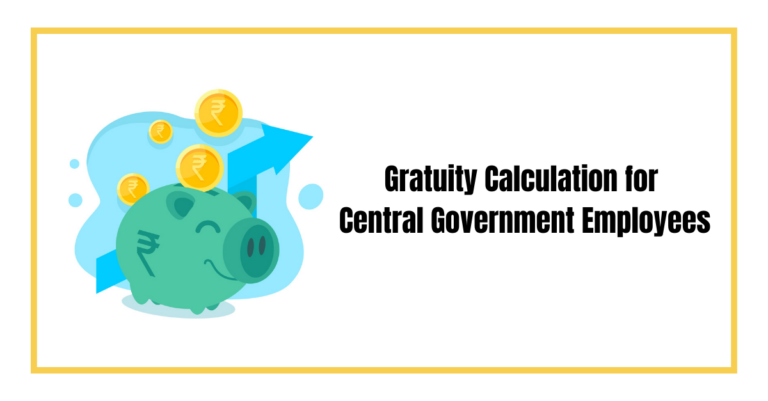Synopsis: Delve into the world of gratuity in India, understanding its calculation and eligibility criteria. Utilize the gratuity calculator to navigate through its complexities and stay informed about the rules governing gratuity.
Gratuity Calculation in India
Why To do Gratuity Calculation?
Gratuity calculation is an essential aspect of payroll management and employee benefits. It helps in understanding the financial implications of retirement and ensures that employees receive their entitled benefits. The calculation of gratuity is crucial for both employees and employers to ensure compliance with the law and to provide a secure financial future for employees post-retirement. Know How to Calculate Gratuity In India!
Understanding the Gratuity Term?
Gratuity is a sum of money paid by an employer to an employee for the services rendered over a term of 5 years, typically at the time of retirement. It is an important addition to an employee’s retirement benefits and serves as a form of financial security. This term is particularly significant for workers in the public and private sectors, as it directly impacts their post-retirement financial stability.
What Are the Types of Gratuity in India?
In India, there are major categories of gratuity based on the type of employment and the coverage under specific regulations:
- Employees covered under the Gratuity Act
- Employees not covered under the Gratuity Act
These categories determine the calculation and disbursement of gratuity for state, central, and government employees, ensuring that they receive their entitled benefits based on the applicable regulations.
How Your Gratuity is Calculated in India?
The calculation of gratuity in India is based on specific parameters and formulas, ensuring that employees receive their entitled benefits. The gratuity amount is calculated using the following formula:
Gratuity=
26
n×b×15
Where:
- n denotes the tenure of service completed in the organization
- b denotes the last drawn salary plus dearness allowance
This calculation is crucial for employees to understand the amount they are eligible to receive based on their tenure, salary and the organization’s coverage under the Gratuity Act.
What Are the New Rules of Gratuity?
The new rules of gratuity in India primarily focus on the calculation of wages, the number of years of service, and the entitlement of employees to receive 15 days of wages for each completed year of service. These rules ensure that employees are fairly compensated based on their years of service and the prevailing wage rates, providing them with a clear understanding of their gratuity entitlements.
What is Gratuity Calculator?
The gratuity calculator is a simplified way to get your accurate amount of gratuity. We do not have to indulge in the complex formula of the gratuity; instead, just by giving input about your last withdrawn monthly salary and completed years of service in that organisation and it will Calculate gratuity in India.
What Is the Formula to Calculate Gratuity in India?
CASE 1: Employer covered under The Payment of Gratuity Act, 1972
As per The Payment of Gratuity Act, 1972, employers covered under the Act are liable for the payment of gratuity to the Employees (who have completed 5 years of service):
Gratuity amount = (salary last drawn * completed years of service)*15/26
Where,
Salary last drawn = Monthly (basic salary dearness allowance)
Completed years of service = Period of service
(Full years 6 months or more rounded off to full year)
CASE 2: Employer not covered under The Payment of Gratuity Act, 1972
If the employer is not covered under The Payment of Gratuity Act, 1972, the employer is not restricted to making such a payment voluntarily. The formula for calculation:-
Gratuity amount = (salary last drawn * completed years of Service)*15/30
Where,
Salary last drawn = monthly (basic salary dearness allowance)
Completed years of service = period of service
(Full years 6 months or more rounded off to full year)
The basic difference between the above two cases is that Instead of 26 in the base, 30 have been used.
Example:-
Mr A served Motors Limited for:-
- 10 Years & 8 months
- 10 Years & 5 months
Last drawn monthly salary – basic – ₹ 1, 00,000 & dearness allowance – ₹ 20,000. We are going to calculate the gratuity amount under the following two scenarios:
Scenario 1: Employer covered under The Payment of Gratuity Act, 1972
Scenario 2: Employer not covered under The Payment of Gratuity Act, 1972
Scenario 1:
Now, the gratuity amount would be calculated as under:-
Gratuity amount = (salary last drawn * completed years of Service)*15/26
- Gratuity amount = (1,20,000 *11 )*15/26 = ₹ 7,61,538.46
- Gratuity amount = (1,20,000 *10 )*15/26 = ₹ 6,92,307.69
Scenario 2:
Now, the gratuity amount would be calculated as under:-
Gratuity amount = (salary last drawn * completed years of service)*15/30
- Gratuity amount = (1,20,000 *11 )*15/30 = ₹ 6,60,000
- Gratuity amount = (1,20,000 *10 )*15/30 = ₹ 6,00,000
Since the period of service is 10 years & 8 months in the first case, in both of the above scenarios, it is rounded off to 11 years.
What are the Rules for calculating Gratuity under The Income Tax Act, 1961?
Gratuity is a one-time benefit received by an employee or his legal heir from his employer on the occurrence of certain events. As per The Income Tax Act, 1961, taxability for the same depends upon the class of employees defined as under:-
-
Employees who are covered under The Payment of Gratuity Act, 1972
Any individual employed in a factory, mine, oil field, port, railways, shops & establishments, plantation, or an educational institution, who has had 10 or more employees on any day in the past 12 months – gets covered under The Payment of Gratuity Act, 1972
Once this Act becomes applicable, it remains applicable even if employees are less than 10.
Rule of Exemption:
The minimum of the following is exempt from tax:
❖Last drawn salary ( basic dearness allowance) * period of service*15/26;
❖₹ 20 Lakhs
❖Gratuity received
-
Employees who are not covered under The Payment of Gratuity Act, 1972
If the employer is not covered under the conditions mentioned above i.e., the employer is not liable to pay the gratuity amount to the employee. Then due to Industrial practice, past practices, or voluntarily, an employer can pay the gratuity amount to his employee or legal heir on the occurrence of a certain event.
Rule of Exemption:-
❖Last 10 Months average salary(basic dearness allowance)* period of service* 1/2;
❖₹ 10 Lakhs
❖gratuity received.
-
Employees who served any Government Department
The gratuity amount received by any government employee who has served any department of government, i.e. Central Government Department or State Government Department, or any local authority – is fully exempt in the hands of the employee.
llustrations:-
Mr D served for 20 years with his last drawn salary & dearness allowance is ₹ 2, 50,000, and he received a lump sum amount against gratuity of ₹ 30, 00,000. We have to calculate exemption under the following situations:-
- Situation 1: Covered under The Payment of Gratuity Act, 1972
- Situation 2: Not covered under The Payment of Gratuity Act, 1972
- Situation 3: Government Employee.
Situation 1: Employee covered under The Payment of Gratuity Act 1972. The exemption would be available as the minimum of the following:-
- Last drawn salary*period of service*15/26 = ₹ 2,50,000 * 20 * 15/26 = ₹ 28,84,615.38
- ₹ 20 Lakhs
- Gratuity received = ₹ 30 Lakhs
Exemption available: minimum of the above three is – ₹ 20, 00,000
Situation 2: Employee not covered under The Gratuity Act. The exemption would be available as a minimum of the following:-
- Last 10 months average salary * Period of service*1/2
= ₹ 2, 50,000 * 20 * 15/26 = ₹ 28, 84,615.38
- ₹ 10 Lakhs
- Gratuity received = ₹ 30 Lakhs
Exemption available: minimum of the above three is – ₹ 10, 00,000
Situation 3: An employee serves the government department:
Exemption available: full amount is exempt i.e. ₹ 30, 00,000.
As we can see, the differentiation in the availability of exemption based on the class of employees is defined under the Income Tax Act, 1961.
Advantages of using Gratuity Calculator to Calculate Gratuity in India:
There are various benefits of using a calculator of Vakil Search to Calculate gratuity in India:-
- It aids in proper Financial Planning; for example, if you are planning to switch an Organisation and have completed 13 years and 5 months, you should switch after 1 month to receive the benefit for the full-year because 6 months or more rounded off to 1 year as illustrated above.
- You are not required to use that complex formula; instead, just by giving simple inputs, the amount calculation would be done by thecalculator online.
- It would assure you 100% accuracy.
- It is easily accessible to you from any remote location, and due to its instant calculation, it saves your time and effort.
Hope this article How to calculate Gratuity in India was helpful!
FAQs
How gratuity is calculated?
Gratuity is calculated by multiplying the last drawn salary by the number of years of service and by 15/26.
Formula: Gratuity = Last drawn salary * Number of years of service * 15/26
How much is gratuity in 5 years?
Gratuity in 5 years would be 7.5 months of the last drawn salary.
Formula: Gratuity = Last drawn salary * 7.5/12
How gratuity is calculated, 26 days or 30 days?
Gratuity is calculated on a monthly basis, assuming 30 days in a month.
Formula: Gratuity = Last drawn salary * Number of years of service * 15/30
Can I get a gratuity if I resign?
Yes, you can get gratuity if you resign, but only if you have completed five years of continuous service with the company.
What are the new gratuity rules for 2023?
There are no new gratuity rules for 2023. The gratuity rules are the same as they were in 2022.
Is 4.8 years eligible for gratuity?
No, 4.8 years is not eligible for gratuity. You must complete five years of continuous service with the company to be eligible for gratuity.
How much is gratuity in CTC?
Gratuity is not included in CTC. CTC stands for the cost to the company, and it includes all the expenses that the company incurs on an employee, such as salary, bonus, leave travel allowance, etc. Gratuity is a one-time payment that is paid to an employee when they leave the company after completing five years of service.
Is five years mandatory for gratuity?
Yes, five years of continuous service is mandatory to be eligible for gratuity.
Is gratuity part of CTC?
No, gratuity is not part of CTC.
Why gratuity is multiplied by 15?
Gratuity is multiplied by 15 to compensate the employee for the loss of wages that they will incur during the period of unemployment after leaving the company.
Is 4.7 years eligible for gratuity?
No, 4.7 years is not eligible for gratuity. You must complete five years of continuous service with the company to be eligible for gratuity.
What is gratuity in a private company?
Gratuity is a benefit that is paid to an employee when they leave the company after completing five years of service. Gratuity is mandatory for all companies, including private companies, with ten or more employees.
What is the new rule for gratuity eligibility?
There is no new rule for gratuity eligibility. The gratuity eligibility rules are the same as they were in 2022.
Who is not eligible for gratuity?
The following employees are not eligible for gratuity: Employees who have not completed five years of continuous service with the company. Employees who are dismissed from the company for misconduct. Employees who resign from the company without giving proper notice.
What is the time limit for gratuity?
The time limit for claiming gratuity is 30 days from the date of leaving the company.
What happens if an employee leaves before completing 5 years of service?
If an employee leaves before completing 5 years of service, they are not eligible for gratuity unless the termination is due to death or disability.
Is there a specific form or process to claim Gratuity in India?
Yes, to claim gratuity in India, an employee needs to file an application with the employer. The employer then calculates the gratuity amount and disburses it within 30 days of receiving the application.
How Can employers offer higher gratuity than the statutory limit?
Employers can offer higher gratuity than the statutory limit voluntarily as a gesture of appreciation for an employee's service. However, the statutory limit is ₹20 lakhs, and any amount above this is considered ex-gratia.
Is Gratuity part of an employee's CTC (Cost to Company)?
Yes, gratuity is part of an employee's CTC and is a statutory benefit provided under the Payment of Gratuity Act, 1972, for employees who have completed at least 5 years of continuous service.
When Can I Withdraw Gratuity Amount?
The gratuity amount can be withdrawn after an employee resigns or retires, and the process involves filing an application with the employer, who then calculates and disburses the gratuity within a specified time frame.
Helpful Links










